Optimal Design of a Lightweight Terahertz Absorber Featuring Ultra-Wideband Polarization-Insensitive Characteristics
Abstract
1. Introduction
2. Materials and Methods
3. Results
3.1. Result Analysis
3.2. Loss Analysis of Dielectric Layer and Top ITO Layer
3.3. Analysis of Wide-Angle Absorption and Polarization Insensitivity
4. Conclusions
Author Contributions
Funding
Institutional Review Board Statement
Informed Consent Statement
Data Availability Statement
Conflicts of Interest
Abbreviations
| THz | Terahertz |
| PS | Polystyrene |
| PET | Polyethylene terephthalate |
| ITO | Indium tin oxide |
| TE | Transverse electric |
| TM | Transverse magnetic |
References
- Yao, J.Q.; Li, J.; Zhang, Y.T.; Ding, X.; Wu, L. Technology for terahertz wave manipulation: Harnessing the light of terahertz. Chin. J. Nat. 2023, 45, 1–16. [Google Scholar]
- Liang, D.C.; Wei, M.G.; Gu, J.Q.; Yin, Z.P.; Ouyang, C.M.; Tian, Z.; He, M.X.; Han, J.G.; Zhang, W.L. Broad-band time domain terahertz radar cross-section research in scale models. Acta Phys. Sin. 2014, 63, 214102. [Google Scholar] [CrossRef]
- Matsumoto, H.; Watanabe, I.; Kasamatsu, A.; Monnai, Y. Integrated terahertz radar based on leaky-wave coherence tomography. Nat. Electron. 2020, 3, 122–129. [Google Scholar] [CrossRef]
- Chen, H.; Ma, W.; Huang, Z.; Zhang, Y.; Huang, Y.; Chen, Y. Graphene-Based Materials toward Microwave and Terahertz Absorbing Stealth Technologies. Adv. Opt. Mater. 2019, 7, 1801318. [Google Scholar] [CrossRef]
- Sun, B.; Huang, L.R.; Ding, J.F.; Luo, Y.; Zhang, Y.Z.; Li, R.Z.; Wang, X.C.; Wen, Q.Y.; Xiao, S.Y. Flexible and transparent metadevices for terahertz, microwave, and infrared multispectral stealth based on modularization design. Opt. Express 2023, 31, 8650–8667. [Google Scholar] [CrossRef]
- Jin, Y.; Yu, H.; Wang, Y.; Wang, L.; Nan, B. Recent Progress in Electromagnetic Wave Absorption Coatings: From Design Principles to Applications. Coatings 2024, 14, 607. [Google Scholar] [CrossRef]
- Liu, Y.P.; Dong, L.; Sabri, M.F.M.; Majid, N.A.; Ibrahim, S. Advancements in tunable and multifunctional metamaterial absorbers: A comprehensive review of microwave to terahertz frequency range. J. Phys. D Appl. Phys. 2024, 57, 293002. [Google Scholar] [CrossRef]
- Chen, H.T.; Taylor, A.J.; Yu, N.F. A review of metasurfaces: Physics and applications. Rep. Prog. Phys. 2016, 7, 076401. [Google Scholar] [CrossRef]
- Li, F.J.; Wang, S.; Zhong, R.; Hu, M.X.; Jiang, Y.; Zheng, M.J.; Wang, M.; Li, X.P.; Peng, R.W.; Den, Z.L. Metasurface polarization optics: From classical to quantum. Appl. Phys. Rev. 2024, 11, 041332. [Google Scholar] [CrossRef]
- Ji, L.; Varadan, V.V. Negative refractive index and negative refraction of waves in lossy metamaterials. Electron. Lett. 2016, 52, 260–261. [Google Scholar] [CrossRef]
- Cai, T.; Zheng, B.; Lou, J.; Shen, L.; Yang, Y.; Tang, S.; Li, E.; Qian, C.; Chen, H. Experimental Realization of a Superdispersion-Enabled Ultrabroadband Terahertz Cloak. Adv. Mater. 2022, 34, 2205053. [Google Scholar] [CrossRef]
- Zhang, Q.; Li, G.; Wu, L.; Yang, F.; Yue, Z.; Zheng, C.; Zhang, Y.; Li, L.; Yao, J.Q. Chip-integrated polarization multiplexed metasurface for simultaneous generation of versatile terahertz vortices. Nanophotonics 2025, 14, 2219–2228. [Google Scholar] [CrossRef] [PubMed]
- Xiang, X.C.; Feng, L.C.; Yang, S.X.; Zhang, W.; Zhang, C.H.; Wu, J.B.; Fan, K.; Jin, B.B.; Chen, J.; Wang, H.B.; et al. Focusing enhancement of terahertz surface plasmon polaritons. Appl. Phys. Lett. 2023, 122, 151101. [Google Scholar] [CrossRef]
- Zhang, T.; Guo, T.M.; Yan, J.Y.; Pei, Y.A. Design of Tunable Four-Broadband Terahertz Absorber. Acta Opt. Sin. 2024, 44, 0523002. [Google Scholar]
- Cheng, X.; Huang, R.; Xu, J.; Xu, X. Broadband Terahertz Near-Perfect Absorbers. ACS Appl. Mater. Interfaces 2020, 12, 33352–33360. [Google Scholar] [CrossRef] [PubMed]
- Paddubskaya, A.; Novitsky, A.; Valynets, N.; Kumar, M.; Itkonen, T.; Pekkarinen, M.; Soboleva, E.; Lahderanta, E.; Kafesaki, M.; Svirko, Y.; et al. All-graphene perfect broadband THz absorber. Carbon 2021, 185, 709–716. [Google Scholar] [CrossRef]
- Zeng, D.; Zong, S.; Liu, G.; Yuan, W.; Liu, X.; Liu, Z. Dynamically electrical/thermal-tunable perfect absorber for a high-performance terahertz modulation. Opt. Express 2022, 30, 39736–39746. [Google Scholar] [CrossRef]
- Zhang, K.; Xia, F.; Li, S.; Liu, Y.; Kong, W. Actively tunable multi-band terahertz perfect absorber due to the hybrid strong coupling in the multilayer structure. Opt. Express 2021, 29, 28619–28630. [Google Scholar] [CrossRef]
- Yi, N.N.; Zong, R.; Gong, J.; Duan, T.; Qian, R.R. Single-/Dual-Band Switchable Terahertz Absorber Based on Vanadium Dioxide-Dirac Semi-Metal Hybrid Metamaterial. Chin. J. Lasers 2022, 49, 0314002. [Google Scholar]
- Meng, T.; Hu, D.; Zhu, Q. Design of a five-band terahertz perfect metamaterial absorber using two resonators. Opt. Commun. 2018, 415, 151–155. [Google Scholar] [CrossRef]
- Wang, T.L.; Qu, L.Z.; Qu, L.F.; Zhang, Y.P.; Zhang, H.Y.; Cao, M.Y. Tunable broadband terahertz metamaterial absorber using multi-layer black phosphorus and vanadium dioxide. J. Phys. D Appl. Phys. 2020, 53, 145105. [Google Scholar] [CrossRef]
- Wang, B.X.; Duan, G.Y.; Xu, C.Y.; Jiang, J.Y.; Xu, W.; Pi, F.W. Design of multiple-frequency-band terahertz metamaterial absorbers with adjustable absorption peaks using toothed resonator. Mater. Des. 2023, 225, 111586. [Google Scholar] [CrossRef]
- Rengasamy, S.; Natarajan, R.; Kuttathati Srinivasan, V. Miniaturized Multi-Spectral Perfect Metamaterial Absorber for THz Sensing, Imaging and Spectroscopic Applications. Plasmonics 2023, 18, 643–651. [Google Scholar] [CrossRef]
- Qi, L.; Liu, C.; Shah, S.M.A. A broad dual-band switchable graphene-based terahertz metamaterial absorber. Carbon 2019, 153, 179–188. [Google Scholar] [CrossRef]
- Ali, A.; Mitra, A.; Aïssa, B. Metamaterials and Metasurfaces: A Review from the Perspectives of Materials, Mechanisms and Advanced Metadevices. Nanomaterials 2022, 12, 1027. [Google Scholar] [CrossRef] [PubMed]
- Wang, Y.Z.; Xu, H.X.; Wang, C.H.; Wang, M.Z.; Wang, S.J. Research progress of electromagnetic metamaterial absorbers. Acta Phys. Sin. 2020, 69, 134101. [Google Scholar] [CrossRef]
- Li, S.J.; Wu, P.X.; Xu, H.X.; Zhou, Y.L.; Cao, X.Y.; Han, J.F.; Zhang, C.; Yang, H.H.; Zhang, Z. Ultra-wideband and Polarization-Insensitive Perfect Absorber Using Multilayer Metamaterials, Lumped Resistors, and Strong Coupling Effects. Nanoscale Res. Lett. 2018, 13, 386. [Google Scholar] [CrossRef]
- Xiao, D.Y.; Zhu, M.M.; Wang, Q.; Sun, L.M.; Zhao, C.; Ng, Z.K.; Teo, E.H.T.; Hu, F.J.; Tu, L.C. A flexible and ultra-broadband terahertz wave absorber based on graphene-vertically aligned carbon nanotube hybrids. Mater. Chem. C 2020, 8, 7244–7252. [Google Scholar] [CrossRef]
- Zhao, G.Z.; Mors, M.T.; Wenckebach, T.; Planken, P.C.M. Terahertz dielectric properties of polystyrene foam. J. Opt. Soc. Am. B 2002, 19, 1476–1479. [Google Scholar] [CrossRef]
- Wen, Q.Y.; Xie, Y.S.; Zhang, H.W.; Yang, Q.H.; Li, Y.X.; Liu, Y.L. Transmissionline model and fields analysis ofmetamaterial absorber in the terahertz band. Opt. Express 2009, 17, 20256–20265. [Google Scholar] [CrossRef] [PubMed]
- Notaros, B.M. Electromagnetics; Prentice Hall: Upper Saddle River, NJ, USA, 2011. [Google Scholar]
- Holm, R.T. Handbook of Optical Constants of Solids; Academic Press: Cambridge, MA, USA, 1998. [Google Scholar]
- Costa, F.; Monorchio, A.; Manara, G. Efficient Analysis of Frequency-Selective Surfaces by a Simple Equivalent-Circuit Model. IEEE Antennas Propag. Mag. 2012, 54, 35–48. [Google Scholar] [CrossRef]
- Yuan, X.; Xu, Y.; Chen, M.; Cheng, X.; Fang, D. Blocking gate resonator rasorber surface brings wide band electromagnetic absorption performance approaching theoretical limit. Microw. Opt. Technol. Lett. 2019, 61, 1524–1528. [Google Scholar] [CrossRef]
- Wheeler, H. Simple relations derived fom a phased-array antenna made of an infinite current sheet. IEEE Trans. Antennas Propag. 1965, 13, 506–514. [Google Scholar] [CrossRef]
- Smith, D.R.; Vier, D.C.; Koschny, T.; Soukoulis, C.M. Electromagnetic parameter retrieval from inhomogeneous metamaterials. Phys. Rev. E 2005, 71, 036617. [Google Scholar] [CrossRef] [PubMed]
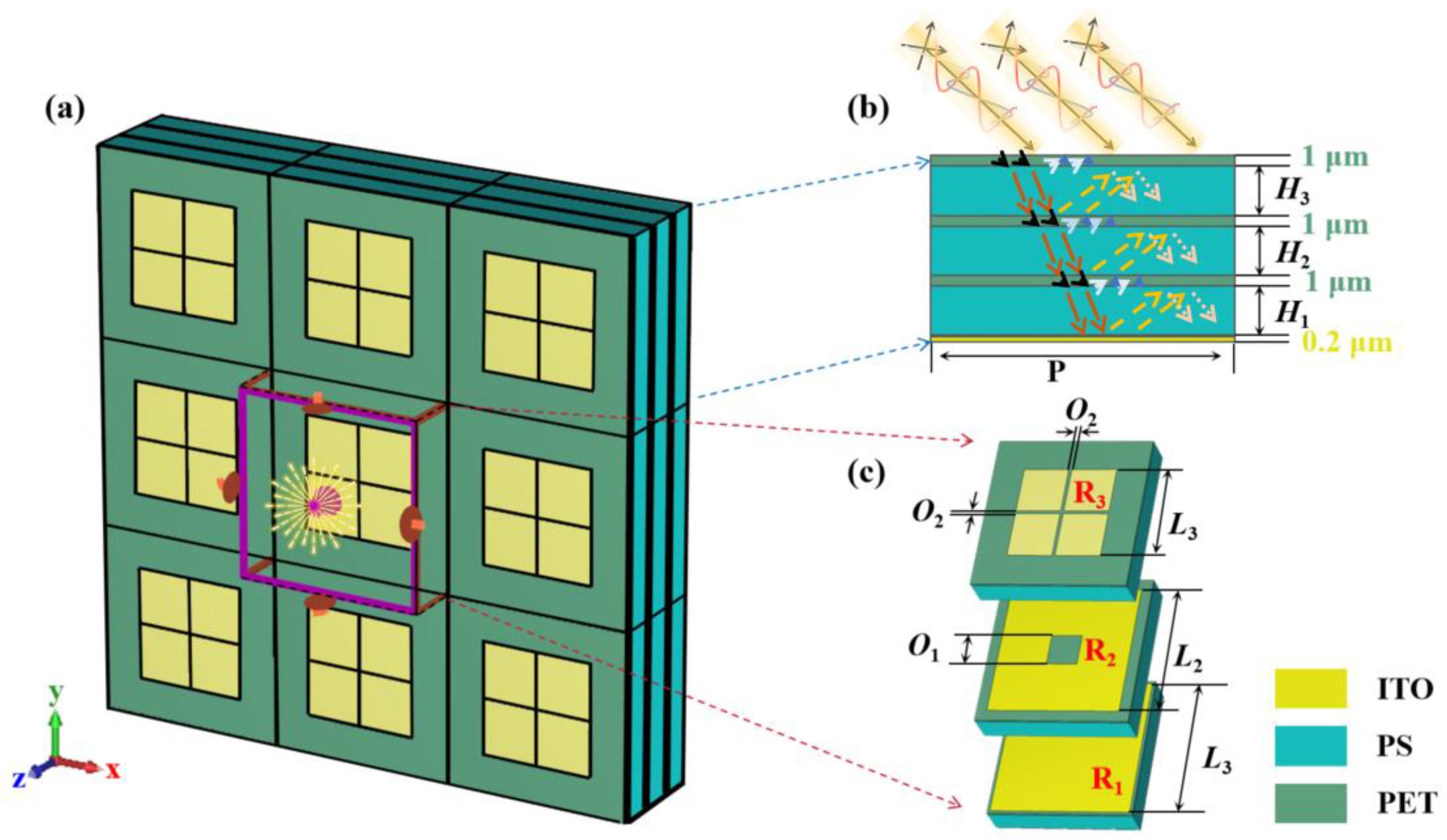

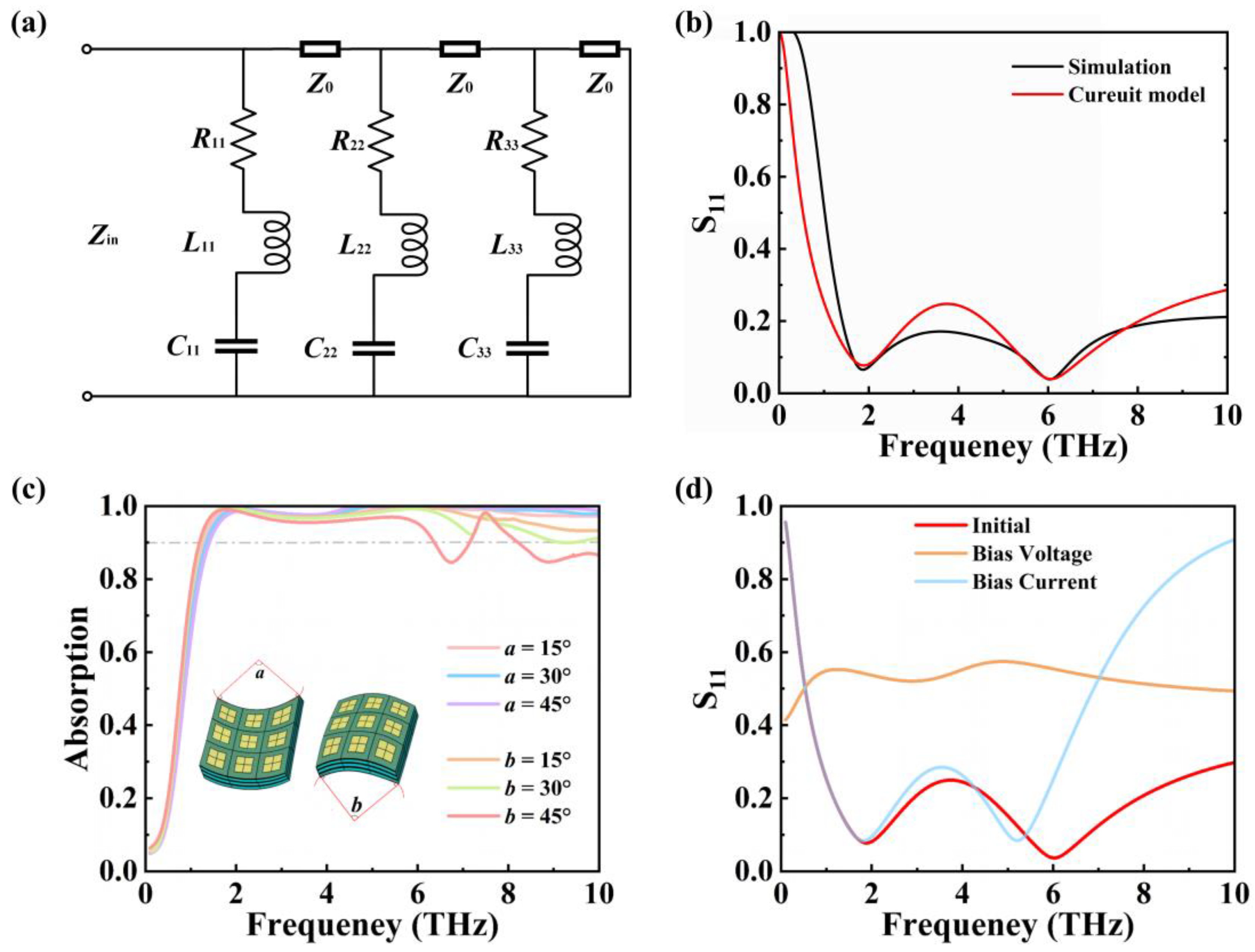
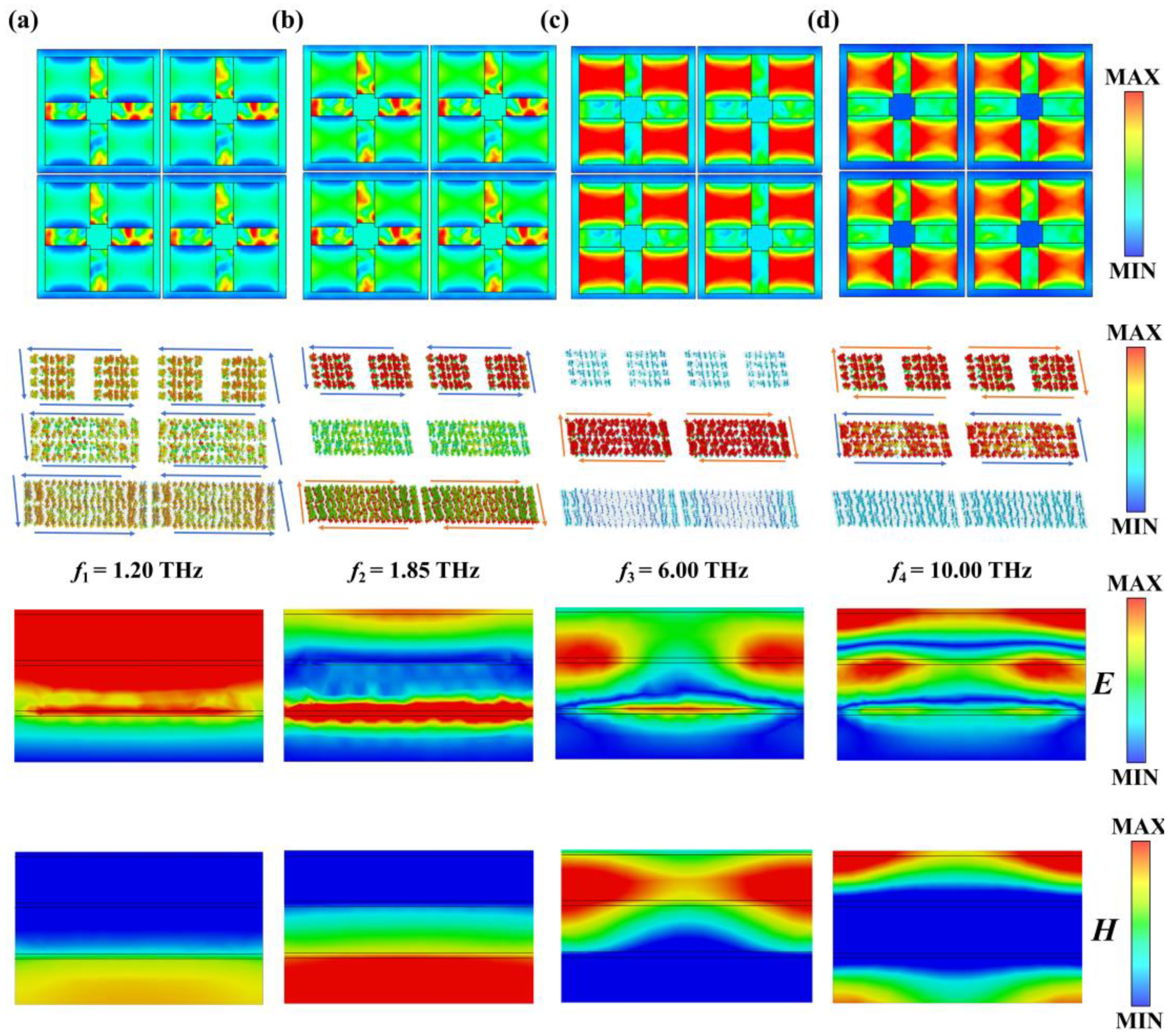

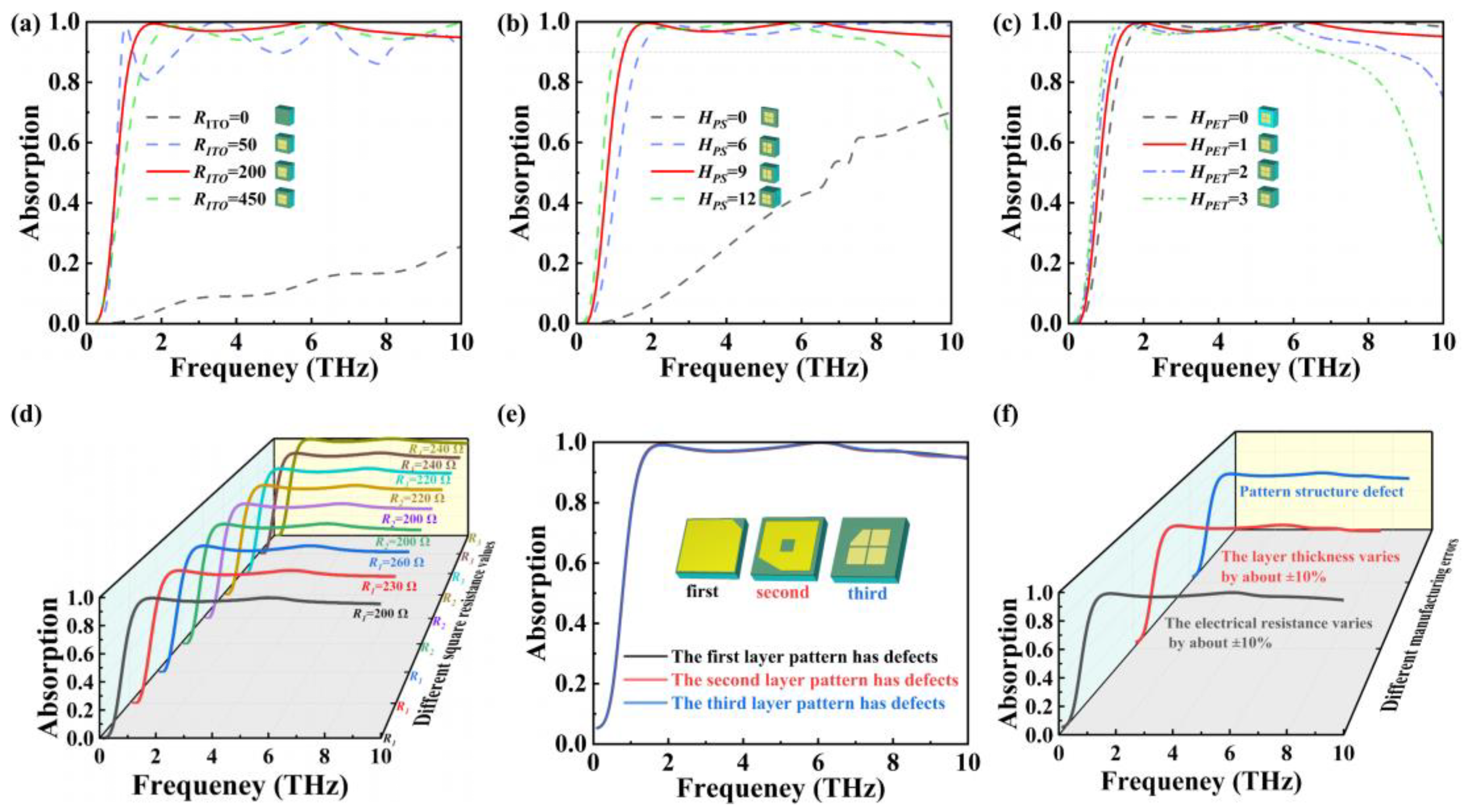
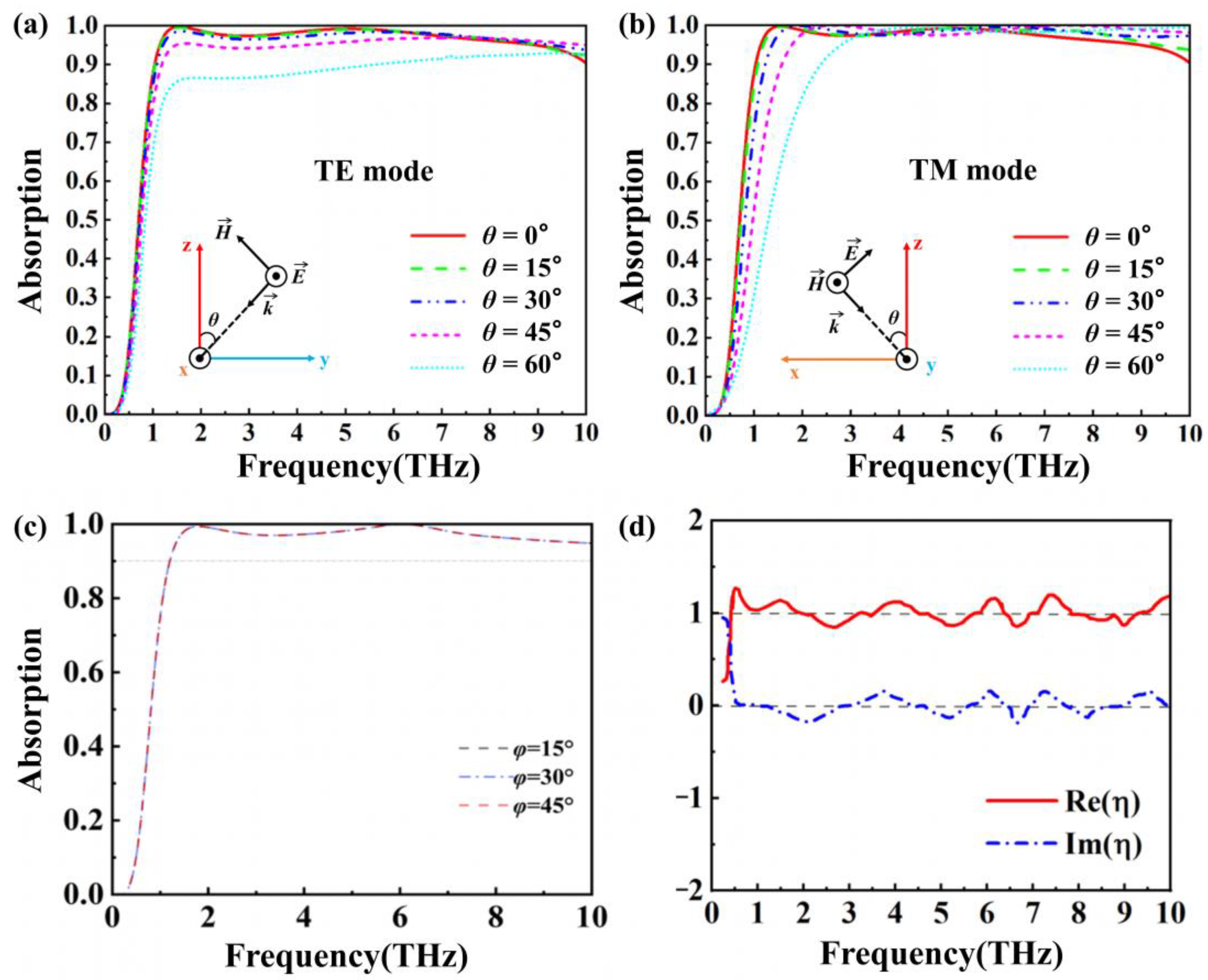
| Parameter | Value |
|---|---|
| R11 | 21 Ω |
| L11 | 80 fH |
| C11 | 0.53 fF |
| R22 | 54 Ω |
| L22 | 3.16 pH |
| C22 | 0.38 fF |
| R33 | 47 Ω |
| L33 | 3.25 pH |
| C33 | 5.03 fF |
Disclaimer/Publisher’s Note: The statements, opinions and data contained in all publications are solely those of the individual author(s) and contributor(s) and not of MDPI and/or the editor(s). MDPI and/or the editor(s) disclaim responsibility for any injury to people or property resulting from any ideas, methods, instructions or products referred to in the content. |
© 2025 by the authors. Licensee MDPI, Basel, Switzerland. This article is an open access article distributed under the terms and conditions of the Creative Commons Attribution (CC BY) license (https://creativecommons.org/licenses/by/4.0/).
Share and Cite
Hao, Y.; Li, T.; Zhu, P.; Ma, F.; Wu, H.; Lei, C.; Liu, M.; Liang, T.; Yao, J. Optimal Design of a Lightweight Terahertz Absorber Featuring Ultra-Wideband Polarization-Insensitive Characteristics. Photonics 2025, 12, 787. https://doi.org/10.3390/photonics12080787
Hao Y, Li T, Zhu P, Ma F, Wu H, Lei C, Liu M, Liang T, Yao J. Optimal Design of a Lightweight Terahertz Absorber Featuring Ultra-Wideband Polarization-Insensitive Characteristics. Photonics. 2025; 12(8):787. https://doi.org/10.3390/photonics12080787
Chicago/Turabian StyleHao, Yafeng, Tengteng Li, Pu Zhu, Fupeng Ma, Huijia Wu, Cheng Lei, Meihong Liu, Ting Liang, and Jianquan Yao. 2025. "Optimal Design of a Lightweight Terahertz Absorber Featuring Ultra-Wideband Polarization-Insensitive Characteristics" Photonics 12, no. 8: 787. https://doi.org/10.3390/photonics12080787
APA StyleHao, Y., Li, T., Zhu, P., Ma, F., Wu, H., Lei, C., Liu, M., Liang, T., & Yao, J. (2025). Optimal Design of a Lightweight Terahertz Absorber Featuring Ultra-Wideband Polarization-Insensitive Characteristics. Photonics, 12(8), 787. https://doi.org/10.3390/photonics12080787







